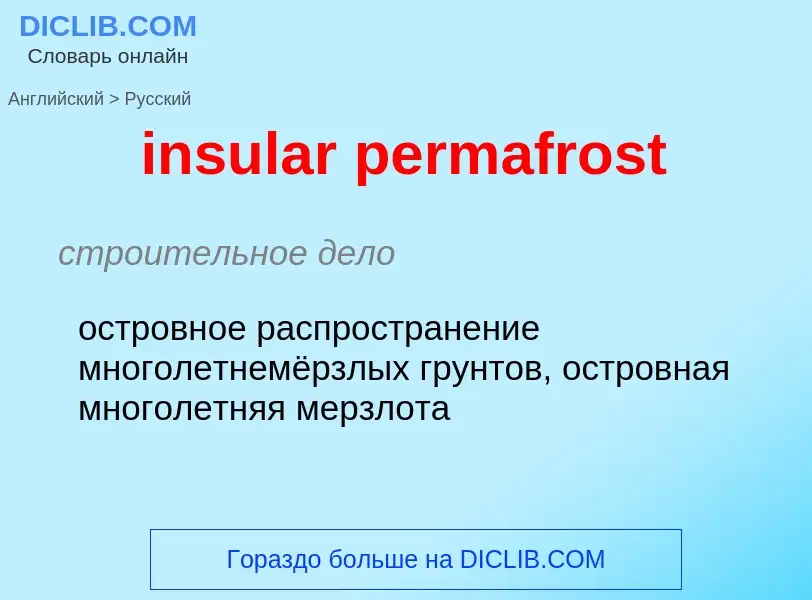Перевод и анализ слов искусственным интеллектом ChatGPT
На этой странице Вы можете получить подробный анализ слова или словосочетания, произведенный с помощью лучшей на сегодняшний день технологии искусственного интеллекта:
- как употребляется слово
- частота употребления
- используется оно чаще в устной или письменной речи
- варианты перевода слова
- примеры употребления (несколько фраз с переводом)
- этимология
insular permafrost - перевод на русский
строительное дело
островное распространение многолетнемёрзлых грунтов, островная многолетняя мерзлота
Определение
Википедия

Permafrost is ground that continuously remains below 0 °C (32 °F) for two or more years, located on land or under the ocean. Most common in the Northern Hemisphere, around 15% of the Northern Hemisphere or 11% of the global surface is underlain by permafrost, with the total area of around 18 million km2. This includes substantial areas of Alaska, Greenland, Canada and Siberia. It is also located in high mountain regions, with the Qinghai–Tibet Plateau a prominent example. Most of the permafrost exists in the Northern Hemisphere, although some is known to exist in the Southern Hemisphere, where it is consigned to mountain slopes like in the Andes or the Southern Alps of New Zealand, and beneath the massive ice sheets of the Antarctic.
In areas underlain by permafrost where the surface temperatures fluctuate annually above and below the freezing point, stable frozen temperatures may occur within a few centimeters of the surface down to hundreds of meters. It may be manifest as persistent ground ice or perennially frozen non-porous bedrock. Permafrost often comprises ice holding various types of soil, sand, and rock in combination.
Permafrost contains large amounts of dead biomass which had accumulated throughout millennia without having had the chance to fully decompose and release its carbon, making tundra soil a carbon sink. As global warming heats the ecosystem, frozen soil thaws and becomes warm enough for decomposition to start anew, accelerating permafrost carbon cycle in one of the effects of climate change. Depending on conditions at the time of thaw, decomposition can either release carbon dioxide or methane, and these greenhouse gas emissions act as a climate change feedback.
The emissions from thawing permafrost will have a sufficient impact on the climate to impact global carbon budgets. Exact estimates of permafrost emissions are hard to model because of the uncertainty about different thaw processes, but there's a widespread agreement they'll be smaller than anthropogenic emissions and not large enough to result in "runaway warming". Permafrost thaw also risks the collapse of buildings and other infrastructure which were built on it when it was stable, with estimates suggesting that nearly 70% of such infrastructure is at risk by 2050, and that the associated costs could rise to tens of billions of dollars in the second half of the century.


![Southern limit of permafrost in [[Eurasia]] according to Karl Ernst von Baer (1843), and other authors. Southern limit of permafrost in [[Eurasia]] according to Karl Ernst von Baer (1843), and other authors.](https://commons.wikimedia.org/wiki/Special:FilePath/K.E.vonBaer 1840 03.jpg?width=200)

.png?width=200)
![Slope failure of permafrost soil, revealing the top of an [[ice wedge]]. Slope failure of permafrost soil, revealing the top of an [[ice wedge]].](https://commons.wikimedia.org/wiki/Special:FilePath/Permafrost - ice wedge.jpg?width=200)
![Excavating ice-rich permafrost with a [[jackhammer]] in [[Alaska]].]]
. The middle zone is permanently frozen as “permafrost”, and the bottom layer is where the geothermal temperature is above freezing. Note the importance of the vertical 0° C line: It denotes the bottom of the active layer in the seasonally variable temperature zone and the bottom limit of permafrost as the temperature increases with depth.---> Excavating ice-rich permafrost with a [[jackhammer]] in [[Alaska]].]]
. The middle zone is permanently frozen as “permafrost”, and the bottom layer is where the geothermal temperature is above freezing. Note the importance of the vertical 0° C line: It denotes the bottom of the active layer in the seasonally variable temperature zone and the bottom limit of permafrost as the temperature increases with depth.--->](https://commons.wikimedia.org/wiki/Special:FilePath/Vertical Temperature Profile in Permafrost (English Text).jpg?width=200)
![A group of [[palsa]]s, as seen from above, formed by the growth of ice lenses. A group of [[palsa]]s, as seen from above, formed by the growth of ice lenses.](https://commons.wikimedia.org/wiki/Special:FilePath/Palsaaerialview.jpg?width=200)
![A peat plateau complex south of [[Fort Simpson]], [[Northwest Territories]] A peat plateau complex south of [[Fort Simpson]], [[Northwest Territories]]](https://commons.wikimedia.org/wiki/Special:FilePath/Peat Plateau Complex.jpg?width=200)
![[[Pingo]]s near [[Tuktoyaktuk]], [[Northwest Territories]], Canada [[Pingo]]s near [[Tuktoyaktuk]], [[Northwest Territories]], Canada](https://commons.wikimedia.org/wiki/Special:FilePath/Pingos near Tuk.jpg?width=200)
![Ground polygons]] Ground polygons]]](https://commons.wikimedia.org/wiki/Special:FilePath/Permafrost - polygon.jpg?width=200)
![Stone rings]] on [[Spitsbergen]] Stone rings]] on [[Spitsbergen]]](https://commons.wikimedia.org/wiki/Special:FilePath/Permafrost stone-rings hg.jpg?width=200)
![[[Ice wedge]]s seen from top [[Ice wedge]]s seen from top](https://commons.wikimedia.org/wiki/Special:FilePath/Ice-wedge hg.jpg?width=200)
![[[Solifluction]] on [[Svalbard]] [[Solifluction]] on [[Svalbard]]](https://commons.wikimedia.org/wiki/Special:FilePath/Permafrost soil-flow hg.jpg?width=200)
![Contraction crack ([[ice wedge]]) polygons on Arctic sediment. Contraction crack ([[ice wedge]]) polygons on Arctic sediment.](https://commons.wikimedia.org/wiki/Special:FilePath/Permafrost pattern.jpg?width=200)
![Thawing permafrost in [[Herschel Island]], Canada, 2013 Thawing permafrost in [[Herschel Island]], Canada, 2013](https://commons.wikimedia.org/wiki/Special:FilePath/Permafrost in Herschel Island 001.jpg?width=200)
![Permafrost and ice in [[Herschel Island]], Canada, 2012 Permafrost and ice in [[Herschel Island]], Canada, 2012](https://commons.wikimedia.org/wiki/Special:FilePath/Permafrost in Herschel Island 015.jpg?width=200)

![Phoenix lander]]. Phoenix lander]].](https://commons.wikimedia.org/wiki/Special:FilePath/Phoenix_Sol_0_horizon.jpg?width=200)
![False-color [[Mars Reconnaissance Orbiter]] image of polygonal surface pattern. False-color [[Mars Reconnaissance Orbiter]] image of polygonal surface pattern.](https://commons.wikimedia.org/wiki/Special:FilePath/PSP 008301 2480 cut a.jpg ?width=200)
![[[Patterned ground]] on earth. [[Patterned ground]] on earth.](https://commons.wikimedia.org/wiki/Special:FilePath/Patterned_ground_devon_island.jpg ?width=200)
![Heat pipes in vertical supports]] maintain a frozen bulb around portions of the [[Trans-Alaska Pipeline]] that are at risk of thawing. Heat pipes in vertical supports]] maintain a frozen bulb around portions of the [[Trans-Alaska Pipeline]] that are at risk of thawing.](https://commons.wikimedia.org/wiki/Special:FilePath/Trans-Alaska Pipeline (1).jpg?width=200)
![Pile foundations in [[Yakutsk]], a city underlain with continuous permafrost. Pile foundations in [[Yakutsk]], a city underlain with continuous permafrost.](https://commons.wikimedia.org/wiki/Special:FilePath/Yakoutsk Construction d'immeuble.jpg?width=200)
![[[District heating]] pipes run above ground in Yakutsk to avoid thawing permafrost. [[District heating]] pipes run above ground in Yakutsk to avoid thawing permafrost.](https://commons.wikimedia.org/wiki/Special:FilePath/Raised pipes in permafrost.jpg?width=200)
